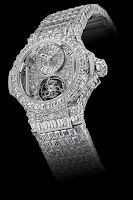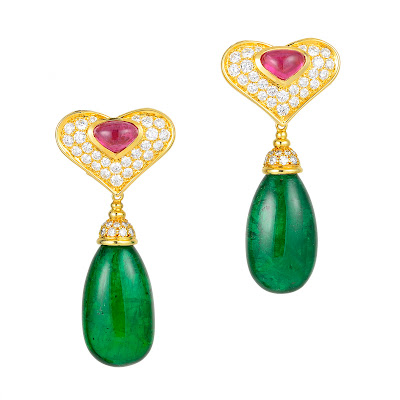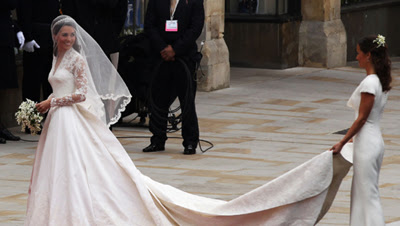 |
| Former owner of Fred Leighton Jewelry, Ralph Esmerian, on February 19, 2007. Photo credit: Marsaili McGrath/Getty Images |
Ralph Esmerian, the former owner and chairman of Manhattan-based luxury jewelry retailer Fred Leighton Holdings Inc., was sentenced in Manhattan federal court to six years in prison for wire fraud, bankruptcy fraud, and concealment of assets in connection with a scheme to embezzle and double-pledge collateral estimated to be worth tens of millions of dollars, Preet Bhara, the U.S. Attorney for the Southern District of New York announced.
Esmerian used the assets to secure more than $210 million in loans to finance his business operations and to purchase Fred Leighton in 2005, which served as a retail outlet for the inventory of his company, R. Esmerian Inc.
U.S. District Judge Denise L. Cote also ordered Esmerian to forfeit $20 million and perform 1,800 hours of community service. In imposing the sentence on July 22, Cote said that Esmerian “lived a life of fraud and deceit on a massive scale.”
In April, Esmerian pled guilty to the crimes. Under the plea agreement, he faced from 97 months to ten years in prison, according to reports.
“Ralph Esmerian tried to game the financial system and the bankruptcy process for years to finance his businesses,” U.S. attorney Bhara said. “As a result of his frauds, the lenders who trusted him have lost tens of millions of dollars.”
 Fred Leighton specializes in vintage jewelry and is often referred to as the “Jeweler to the Stars,” where its museum-quality jewelry, rare artifacts and gems are often found on well-known actors and celebrities during “Red Carpet” events. New York-based jewelry manufacturer and retailer, Kwiat, purchased Fred Leighton in 2009. (pictured left: Amy Adams in Fred Leighton 1950s bib necklace—made up of approximately 630 carats of emeralds, rubies and sapphires. Photo credit: John Shearer/WireImage)
Fred Leighton specializes in vintage jewelry and is often referred to as the “Jeweler to the Stars,” where its museum-quality jewelry, rare artifacts and gems are often found on well-known actors and celebrities during “Red Carpet” events. New York-based jewelry manufacturer and retailer, Kwiat, purchased Fred Leighton in 2009. (pictured left: Amy Adams in Fred Leighton 1950s bib necklace—made up of approximately 630 carats of emeralds, rubies and sapphires. Photo credit: John Shearer/WireImage)According to the criminal complaint filed in U.S. Bankruptcy Court, and statements made in court, Esmerian estimated his inventory to be worth approximately $192.3 million as of December 2006. He financed the purchase of Fred Leighton and REI's business operations by obtaining at least $217 million in loans from Merrill Lynch Mortgage Capital, Inc., Acorn Capital Group, LLC and other sources. In 2005 and 2006, he borrowed approximately $177 million from Merrill Lynch, using as security the inventory of Fred Leighton and a collection of rare jewelry, artifacts and antiquities. However, by the time Esmerian entered into the 2006 loan agreements, he had secretly sold some of the pledged collateral which he estimated to be worth over $3.4 million. Soon thereafter, without informing Merrill Lynch, and what the court deemed to be in violation of the loan agreements, Esmerian sold an additional $1.6 million worth of Merrill Lynch's collateral, and double-pledged over $6 million worth of additional collateral to help secure a $40 million loan from Acorn.
In January 2008, the New York State Supreme Court issued a temporary restraining order, which “Esmerian repeatedly violated by secretly selling additional Merrill Lynch collateral and converting the proceeds to his own use,” according to the U.S. attorney’s statement.
On April 15, 2008, Esmerian caused Fred Leighton to file for Chapter 11 bankruptcy protection. In the course of the bankruptcy proceeding, despite orders of the bankruptcy court, “Esmerian repeatedly and systematically embezzled tens of millions of dollars worth of property of Fred Leighton and related debtor entities, sold that property, and kept the proceeds for himself or to pay off other debts,” according the U.S. attorney’s statement.
Among the Merrill Lynch collateral he sold, were a 13-ct. Burma ruby and diamond ring with an estimated worth of $2.94 million, he sold for $2 million; and rare butterfly brooch consisting of hundreds of virtually flawless colored diamonds valued at approximately $2.45 million.




















































